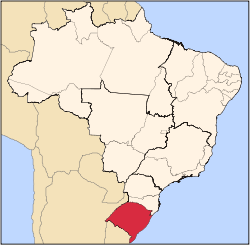This article needs additional citations for verification .(January 2021) |
Mata | |
|---|---|
 | |
 Location in Rio Grande do Sul, Brazil | |
| Coordinates: 29°33′57″S54°27′36″W / 29.56583°S 54.46000°W | |
| Country | Brazil |
| Region | South |
| State | Rio Grande do Sul |
| Government | |
| • Mayor | Sergio Roni Bruning |
| Area | |
• Total | 312.120 km2 (120.510 sq mi) |
| Elevation | 127 m (417 ft) |
| Population (2022 [1] ) | |
• Total | 4,698 |
| • Density | 15/km2 (39/sq mi) |
| Time zone | UTC−3 (BRT) |
Mata is a municipality in Rio Grande do Sul in Brazil.








